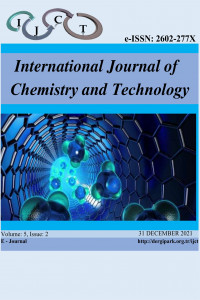Abstract
Supporting Institution
Kirikkale Üniversitesi
Project Number
2016/076
Thanks
Bilimsel ve Teknolojik Araştırmalar Uygulama ve Araştırma Merkezi Müdürlüğü(KÜBTUAM) teşekkür ederiz
References
- Jonas, F.; Heywang, G. Electrochim. Acta. 1994, 39(8-9), 1345-1347.
- O'Hara, P. B.; St. Peter, W.; Engelson, C. J. Chem. Edu. 2005, 82(1), 49.
- Banerji, A.; Tausch, M. W.; Scherf, U. Educ. Química. 2013. 24(1), 17-22.
- Rehahn, M. Chemie in unserer Zeit. 2003, 37(1), 18-30.
- Doğan, M. J. Mater. Sci: Mater. in. Elect. 2021, 32, 22506–22516.
- Ökten, S.; Çakmak, O.; Saddiqa, A.; Keskin, B.; Özdemir, S.; İnal, M. Org. Comms. 2016, 9(4), 82-93.
- Short, B. R.; Vargas, M. A.; Thomas, J. C.; O'Hanlon, S.; Enright, M. C. J Antimicrob. Chemotherapy. 2006, 57(1), 104-109.
- Albrecht, M.; Fiege, M.; Osetska, O. Coordination Chem. Rev. 2008, 252(8-9), 812-824.
- Montes, V. A.; Pohl, R., Shinar, J.; Anzenbacher, P. Chem-A. Eur. J. 2006, 12(17), 4523-4535.
- Bardez, E. Isr. J. Chem. 1999, 39(3-4), 319-332.
- Isshiki, K.; Tsuji, F.; Kuwamoto, T.; Nakayama, E. Anal. Chem. 1987, 59(20), 2491-2495.
- Lakshmi, A.; Balachandran, V.; Janaki, A. J. Mol. Structure. 2011, 1004(1-3), 51-66.
- Ahmed, M. J.; Haque, M. E. Anal. Sci. 2002, 18(4), 433-439.
- Ökten, S.; Cakmak, O.; Erenler, R.; Şahin, Ö. Y.; Tekin, Ş. Turk. J. Chem. 2013, 37(6), 896-908.
- Ökten, S.; Çakmak, O. Tetrahedron. Lett. 2015, 56(39), 5337-5340.
- Ökten, S.; Cakmak, O.; Tekin, S.; Koprulu, T. K. Lett. Drug. Des. Discov. 2017, 14(12), 1415-1424.
- Doğan, M. 2021, Microsc. Res. Techniq. 2021, 84( 11), 2774– 2783.
Abstract
High-priced coating devices limit producing electronic devices and circuit applications widely in laboratories. Simply In this study spin coating technique was used to create surface thin films. Also with this method, an OLED(Organic Light Emitting Diode) device was practically produced. OLED device includes mainly HTL(hole transfer layer), fluorescent layer(light-emitting layer), and an ETL(electron transfer layer). Light-emitting layers in OLED experimental studies are frequently done with commercially produced expensive fluorescence polymers. As an example, MEH-PPV (Poly[2-methoxy-5-(2’-ethyl-hexoxy)-1,4-phenylenevinylene]), Alq3 (Tris-(8-hydroxyquinolinato) aluminum) are mostly known and used fluorescent semiconductor polymers. Alternative to these fluorescent polymers, three different produced quinoline ligand products has fluorescent feature were evaluated. After comparing the fluorescence yields of the produced three complexes, it was seen that 5,7-dibromo-8-hydroxyquinoline has the highest fluorescent response from the others. OLED device production was done with a commercial MEH-PPV(commercial) fluorescent product, and produced (5,7-dibromo-8-hydroxyquinoline). Designed OLED device illumination spectrum was found in the UV(ultraviolet) region. It was concluded that this quoniline product can use as a fluorescent material to produce an OLED device.
Keywords
Project Number
2016/076
References
- Jonas, F.; Heywang, G. Electrochim. Acta. 1994, 39(8-9), 1345-1347.
- O'Hara, P. B.; St. Peter, W.; Engelson, C. J. Chem. Edu. 2005, 82(1), 49.
- Banerji, A.; Tausch, M. W.; Scherf, U. Educ. Química. 2013. 24(1), 17-22.
- Rehahn, M. Chemie in unserer Zeit. 2003, 37(1), 18-30.
- Doğan, M. J. Mater. Sci: Mater. in. Elect. 2021, 32, 22506–22516.
- Ökten, S.; Çakmak, O.; Saddiqa, A.; Keskin, B.; Özdemir, S.; İnal, M. Org. Comms. 2016, 9(4), 82-93.
- Short, B. R.; Vargas, M. A.; Thomas, J. C.; O'Hanlon, S.; Enright, M. C. J Antimicrob. Chemotherapy. 2006, 57(1), 104-109.
- Albrecht, M.; Fiege, M.; Osetska, O. Coordination Chem. Rev. 2008, 252(8-9), 812-824.
- Montes, V. A.; Pohl, R., Shinar, J.; Anzenbacher, P. Chem-A. Eur. J. 2006, 12(17), 4523-4535.
- Bardez, E. Isr. J. Chem. 1999, 39(3-4), 319-332.
- Isshiki, K.; Tsuji, F.; Kuwamoto, T.; Nakayama, E. Anal. Chem. 1987, 59(20), 2491-2495.
- Lakshmi, A.; Balachandran, V.; Janaki, A. J. Mol. Structure. 2011, 1004(1-3), 51-66.
- Ahmed, M. J.; Haque, M. E. Anal. Sci. 2002, 18(4), 433-439.
- Ökten, S.; Cakmak, O.; Erenler, R.; Şahin, Ö. Y.; Tekin, Ş. Turk. J. Chem. 2013, 37(6), 896-908.
- Ökten, S.; Çakmak, O. Tetrahedron. Lett. 2015, 56(39), 5337-5340.
- Ökten, S.; Cakmak, O.; Tekin, S.; Koprulu, T. K. Lett. Drug. Des. Discov. 2017, 14(12), 1415-1424.
- Doğan, M. 2021, Microsc. Res. Techniq. 2021, 84( 11), 2774– 2783.
Details
| Primary Language | English |
|---|---|
| Subjects | Chemical Engineering |
| Journal Section | Research Articles |
| Authors | |
| Project Number | 2016/076 |
| Publication Date | December 31, 2021 |
| Published in Issue | Year 2021 Volume: 5 Issue: 2 |
Cite
Cited By
Titreşimli İnce Film Kaplama Sistemi Tasarımı ve Yüzey Kaplamasının Test Edilmesi
Osmaniye Korkut Ata Üniversitesi Fen Bilimleri Enstitüsü Dergisi
https://doi.org/10.47495/okufbed.1284614
This work is licensed under a Creative Commons Attribution-NonCommercial 4.0 International License.



